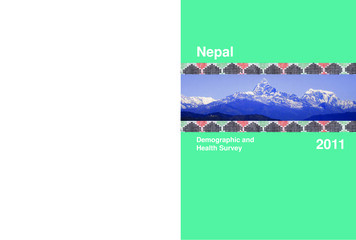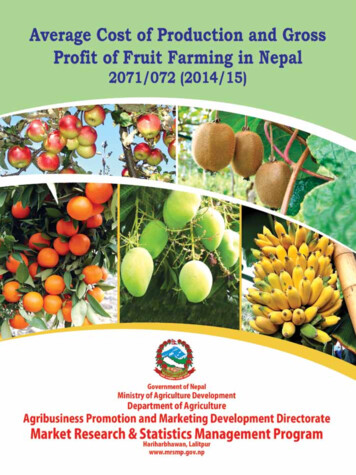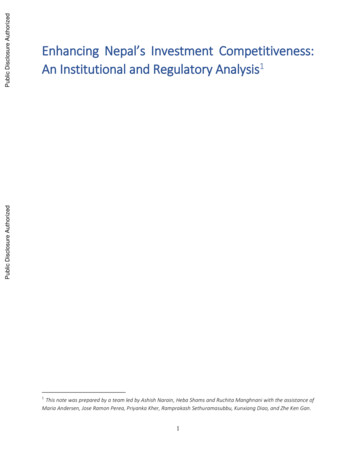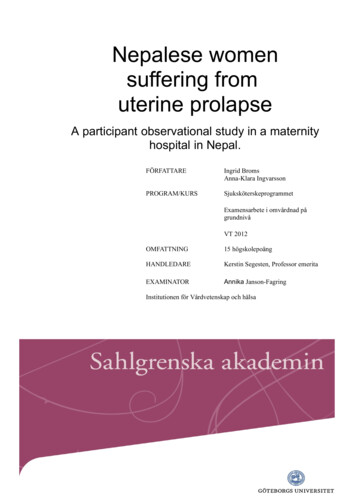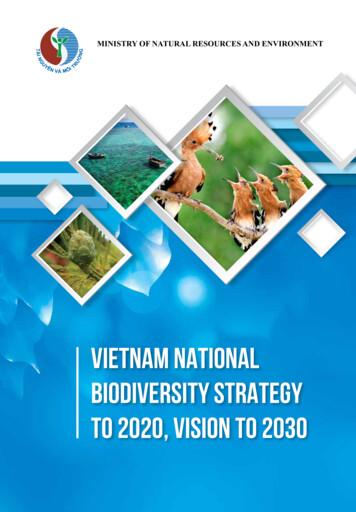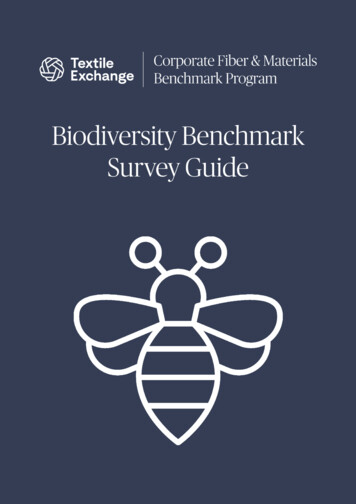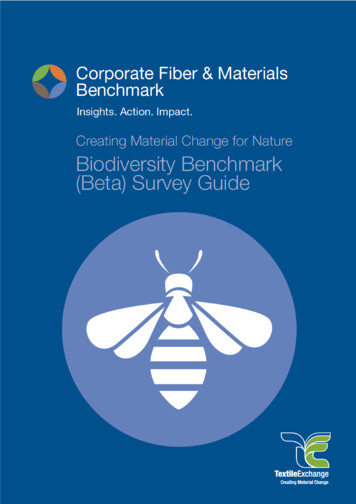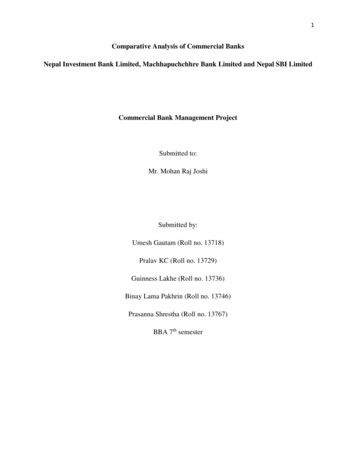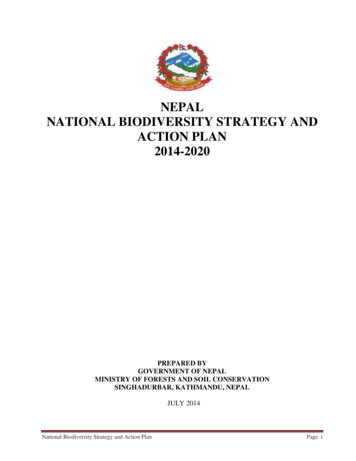
Transcription
NEPALNATIONAL BIODIVERSITY STRATEGY ANDACTION PLAN2014-2020PREPARED BYGOVERNMENT OF NEPALMINISTRY OF FORESTS AND SOIL CONSERVATIONSINGHADURBAR, KATHMANDU, NEPALJULY 2014National Biodiversity Strategy and Action PlanPage i
Government of NepalKATHMANDUNEPALThe Prime MinisterMessageGovernment of Nepal is committed to the conservation and sustainable utilization of biodiversityfor the prosperity of its people and the nation. As Nepal is endowed with rich biological diversity, ithas tremendous potential in reshaping people’s livelihood and economic base of the country. Itsconservation and management through relevant strategy is indispensable. The National BiodiversityStrategy and Action Plan (NBSAP) designed for the period 2014-2020 is aimed to provide astrategic framework for the conservation of Nepal’s biodiversity.The NBSAP envisions a conserved biodiversity contributing for sound and resilient ecosystems andnational prosperity. This document has been revised from the earlier Nepal Biodiversity Strategy(2002) and Implementation Plan (2006-2010) after rigorous and extensive consultations engaging awide range of stakeholders from national to community level.The NBSAP embraces the commitment to fulfill the international obligation as signatory to theConvention on Biological Diversity. I am confident that this strategy will provide a firm basis forplanning and sustainable management of biological diversity across all sector in the country.Finally, I would like to appreciate the efforts made by Mr. Mahesh Acharya, Hon’ble Minister,Ministry of Forests and Soil Conservation (MoFSC) and Dr. Ganesh Raj Joshi, Secretary MoFSCand his team for the preparation of this document.July 2014Sushil Koiralaii
Government of NepalMinistry of Forests and Soil ConservationSingha Durbar, KathamanduForewordNepal strives to achieve sustainable economic growth through wise use of its natural resources. TheGovernment of Nepal fully recognizes that the efforts to economic growth would only besustainable if undertaken through sound environmental management. Accordingly, we are fullycommitted to managing the country’s rich biological diversity as per the national need, and in thespirit of the Convention on Biological Diversity and other relevant multilateral environmentalagreements to which Nepal is a Party. This National Biodiversity Strategy and Action Plan(NBSAP) is a key step forward towards achieving this goal.We are proud to the achievements that the country has made in conserving its biodiversity duringthe past decades. Community based management of forests and agro-biological resources are someof the successful conservation models in the country, which also have direct positive contribution topoverty alleviation. Protected area is another sub-sector that has made impressive progress inbiodiversity conservation in the last few decades. With over 23 percent of its land area underprotection, Nepal now ranks second in Asia and one of the top 20 countries in the world for thepercentage of its surface area that is protected. Population of some mega wildlife species, such astiger and rhinoceros, have been continuously increasing during the past few years. However, somereal threats and challenges are still with us.I would like to take this opportunity to thank all our development and conservation partners for theirsupport and local communities for their sincere efforts to conserve and sustainably use the country’sbiodiversity. We look forward to even stronger cooperation and collaboration among all the nationaland international stakeholders in implementing NBSAP. The Ministry of Forests and SoilConservation (MoFSC) will leave no stone unturned in taking the lead in implementation of thestrategies and priority actions included in this document.I would like to thank Dr. Ganesh R. Joshi, Secretary MoFSC for coordinating the process ofpreparing NBSAP and reviewing it and his entire team and the then secretaries Mr. Keshav P.Bhattarai, Mr. Nabin K. Ghimire and Dr. Krishna C. Poudel for initiating the process.July 2014Mahesh AcharyaMinisteriii
Government of NepalMinistry of Forests and Soil ConservationSingha Durbar, KathmanduAcknowledgementThe unique geographic position and variations in altitude and climate have made Nepal as one of thestorehouses of biological diversity in the world. The Government of Nepal is committed to conserve and usethis important natural resource sustainably for the benefit of the country’s present and future generations.This National Biodiversity Strategy and Action Plan (NBSAP) is a key milestone in the conservation historyof Nepal, following the Biodiversity Profiles of Nepal (1996) and Nepal Biodiversity Strategy (2002). It isalso a testimony of Nepal’s continued commitment towards fulfilling her international obligations. Thedocument provides a comprehensive account of the country’s biodiversity; identifies the threats tobiodiversity; describes the key efforts, achievements and gaps in the management of biodiversity; presentsstrategic approaches, theme-specific strategies and associated priorities for actions; and outlines theimplementation arrangement. The strategies and priority actions take into consideration of the national needsin terms of conservation, sustainable use of its components and equitable sharing of benefits. The strategywill be implemented in collaboration and partnership with all relevant stakeholders. I believe that thedocument like this will attract the attention of both national stakeholders as well as of the global community.Several organizations and individuals, including government agencies, NGOs, members of local user groups,civil society organizations, farmers and individual experts, contributed in different ways to this strategy andaction plan. I would appreciate the efforts and inputs of reviewers namely Mr. Batu K. Uprety, Dr. Ram P.Chaudhary, Dr. Bijay K. Singh, Mr. Bimal K. Baniya, Mr. Shyam Bajimaya, and Mr. Harihar Sigdel. I wouldlike to thank Mr. Braj Kishor Yadav, Joint Secretary MoFSC for coordinating the process and his dedicationand sincere efforts in finalizing this document; Mr. Ram P. Lamsal and Mr. Krishna P. Acharya, and Dr.Annapurna N. Das Joint Secretaries MoFSC and Mr. Bishwa N. Oli, Director General, Department of Forestsfor contributing to enrich the technical quality of this document. The support from IUCN Offices in Nepal,Thailand and Switzerland, especially from Dr. Yam Malla, Dr. Scott Perkin, Dr. Sonia Penamoreno and Dr.Thomas Greiber who provided valuable feedbacks to the draft and Mr. Hermes Huang for editing thedocument is highly appreciated. I would like to thank Mr. Santosh Nepal, WWF and Mr. Top Bahadur Khatrifor their technical inputs and feedback in the process of finalization; and Sagar K. Rimal, Bodh R. Subedi,Govinda B. Shrestha, Madhu Ghimire, Rajendra Dhungana, Hem Raj Acharya and Kapil Khanal, for theirdedication and hard work to complete this task in time. I would also like to express my great appreciation tothe Kathmandu Forestry College team led by Dr. Ambika P. Gautam and members Dr. Bishu H. Pandit, Dr.Deep B. Swar, Dr. Krishna P. Poudel, Dr. Madhusudan Upadhyay, Mr. Narayan Belbase, Mr. Ram C.Khanal, Dr. Shreeram P. Neopane, Dr. Sushila C. Nepali and Mr. Tulshi B. Prajapati for supportingMinistry’s initiation of preparing NBSAP.Successful completion of this work would not have been possible without the support and cooperation ofsenior officials at this Ministry and the departments under it, and various other ministries, departments andoffices. I would like to express my sincere appreciation to all of them. The Ministry is also thankful to all theagencies and individual experts who provided their valuable comments and suggestions.Finally, I would like to express my sincere appreciation to the Global Environment Facility and UnitedNations Environment Programme for their financial support to prepare NBSAP.July 2014Ganesh Raj Joshi, PhDSecretaryiv
Acronyms and OIDORDPRDSCODSCWMBEDAccess and Benefit SharingAnnapurna Conservation AreaAssociation of Collaborative Forest Users NepalAsian Development BankAgriculture Development StrategyAlternative Energy Promotion CenterAnimal Genetic ResourceBird Conservation NepalBuffer Zone Community ForestBuffer Zone Development CouncilConservation AreaConvention on Biological DiversityCommunity Based OrganisationCentral Bureau of StatisticsCentral Department of BotanyClean Development MechanismCommunication, Extension and OutreachCommunity/Forest User GroupConsultative Group on International Agricultural ResearchClearing House MechanismClimate Investment FundsConvention on International Trade in Endangered Species of Wild Fauna and FloraChitwan National ParkConference of PartiesCivil Society OrganisationConservation and Sustainable Use of Wetlands in NepalDistrict Agriculture Development Office/OfficerDistrict Biodiversity Coordination CommitteeDistrict Development CommitteeDepartment for International Development (UK)District Forest Office/OfficerDepartment of Forest Research and SurveyDistrict Forestry Sector Coordination CommitteeDepartment of Livestock ServicesDeoxyribonucleic AcidDepartment of National Parks and Wildlife ConservationDepartment of AgricultureDepartment of ForestsDepartment of IrrigationDepartment of RoadsDepartment of Plant ResourcesDistrict Soil Conservation OfficeDepartment of Soil Conservation and Watershed ManagementBiodiversity and Environment Divisionv
DLNPLPGLRMPLSGAM&EMAPMDGMEAMLJPAMOADEnvironment Friendly Governance District Coordination CommitteeEnvironment Friendly Local Governance FrameworkEnvironment Friendly Local Governance Municipal Coordination CommitteeEnvironment Friendly Local Governance Village Coordination CommitteeEnvironmental Impact AssessmentEnvironment Protection CouncilFood and Agriculture Organization of the United NationsFederation of Community Forestry Users NepalFederation of Nepalese Chamber of Commerce and IndustryForest Resource AssessmentForest Resource Information System ProjectGross Domestic ProductGlobal Environment FacilityGreenhouse GasGeographical IndicationThe German Society for International CooperationGlacial Lake Outburst FloodGovernment of NepalGender and Social InclusionGlobal Taxonomic InitiativeInternational/ Nongovernment OrganisationInvasive Alien SpeciesInternational Centre for Integrated Mountain DevelopmentInternational Food Policy Research InstituteIntergovernmental Panel on Climate ChangeIntegrated Pest ManagementIntegrated Plant Nutrients ManagementIntellectual Property RightsIndigenous Traditional KnowledgeInternational Treaty on Plant Genetic Resources for Food and AgricultureInternational Union for Conservation of NatureLocal Adaptation Plan of ActionLocal Biodiversity Strategy and Action PlanLeast Developed CountryLeasehold Forest User GroupLocal Initiatives for Biodiversity Research and DevelopmentLangtang National ParkLiquefied Petroleum GasLand Resources Mapping ProjectLocal Self-Governance ActMonitoring and EvaluationMedicinal and Aromatic PlantsMillennium Development GoalMultilateral Environmental AgreementMinistry of Law, Justice and Parliamentary AffairsMinistry of Agricultural Developmentvi
APESPGRPGRFAPOWPARECASTREDDSALTSDANSDCMinistry of Culture, Tourism and Civil AviationMinistry of EnergyMinistry of EducationMinistry of FinanceMinistry of Federal Affairs and Local DevelopmentMinistry of Forests and Soil ConservationMinistry of General AdministrationMinistry of IrrigationMinistry of Information and CommunicationsMinistry of IndustryMinistry of Land Reform and ManagementMinistry of Physical Infrastructure and TransportMinistry of Science, Technology and EnvironmentMonitoring, Reporting and VerificationNational Adaptation Programme of ActionNepal Agricultural Research CouncilNepal Academy of Science and TechnologyNational Biodiversity Coordination CommitteeNational Biodiversity Information Management SystemNepal Biodiversity Strategy (2002)National Biodiversity Strategy and Action PlanNepal Biodiversity Strategy Implementation Plan (2006)National Biodiversity UnitNepal Electricity AuthorityNepal Forum of Environmental JournalistsNepal Federation of Indigenous NationalitiesNational Foundation for Development of Indigenous NationalitiesNational Forest InventoryNorwegian Agency for Development CooperationNational Planning CommissionNepali RupeesNational Park and Wildlife Conservation ActNatural Resources ManagementNepal Tourism BoardNon-Timber Forest ProductNational Trust for Nature ConservationOfficial Development AssistancePayment for Ecosystem ServicesPlant Genetic ResourcePlant Genetic Resources for Food and AgricultureProgramme of Work on Protected AreaResearch Centre for Applied Science and TechnologyReducing Emissions from Deforestation and Forest DegradationSloping Agricultural Land TechnologySustainable Development Agenda for NepalSwiss Agency for Development and Cooperationvii
CWCMCWECSWWFStandard Material Transfer AgreementSagarmatha National ParkTerai Arc LandscapeThe Economics of Ecosystems and BiodiversityTree Improvement and Silviculture UnitTribhuvan UniversityUnited Nations Development ProgrammeUnited Nations Environment ProgrammeUnited Nations Educational, Scientific and Cultural OrganizationUnited Nations Framework Convention on Climate ChangeUnited States Agency for International DevelopmentUnited States DollarVillage Development CommitteeWorld Conservation Monitoring CentreWater and Energy Commission SecretariatWorld Wildlife Fundviii
Table of ContentsMessage . iiForeword . iiiAcknowledgement . ivAcronyms and Abbreviations . vTable of Contents . ixList of Tables . xiiList of Figures . xivList of Annexes . xviExecutive Summary . xviiiCHAPTER 1: INTRODUCTION. 11.1 Understanding Biodiversity. 11.2 Importance of Biodiversity. 11.3 Background to the National Biodiversity Strategy and Action Plan . 21.4 Overview of the National Biodiversity Strategy and Action Plan Development Process . 31.5 Structure of the National Biodiversity Strategy and Action Plan . 3CHAPTER 2: THE NATIONAL CONTEXT . 52.1 Country Background . 52.2 Status of Biodiversity . 11CHAPTER 3: THREATS TO BIODIVERSITY IN NEPAL . 253.1 Forest Biodiversity . 253.2 Rangeland Biodiversity . 293.3 Wetland Biodiversity. 303.4 Agro-biodiversity . 313.5 Mountain Biodiversity. 32ix
3.6 Climate Change: a Major Threat to Biodiversity . 323.7. Factors Underlying the Threats . 33CHAPTER 4: EFFORTS, OUTCOMES AND GAPS IN THE MANAGEMENT OFBIODIVERSITY . 364.1 Enabling Policies, Strategies and Regulatory Framework . 364.2 Participation in International Conventions. 374.3 Institutional Development . 384.4 Establishment and Management of Protected Areas . 424.5 Management of Forest Biodiversity outside Protected Area . 464.6 Other Efforts in In-situ and Ex-situ Conservation of Forest Biodiversity. 504.7 Key Gaps, Issues and Challenges in Management of Forest Biodiversity. 534.8 Management of Rangeland Biodiversity . 574.9 Management of Wetland Biodiversity . 574.10 Management of Agrobiodiversity . 584.11 Key Gaps and Issues in Management of Agrobiodiversity . 594.12 Management of Mountain Biodiversity . 604.13 Cross-cutting Efforts and Outcomes . 604.14 Funding for Biodiversity Management in Key Sectors: Sources and Trends . 694.15 Implementation of Nepal Biodiversity Strategy (2002) and Nepal Biodiversity StrategyImplementation Plan (2006): Status, Gaps and Lessons . 72CHAPTER 5: STRATEGY FOR MANAGMENET OF BIODIVERSITY . 765.1 Vision, Goal and Objective . 765.2 Principles Underpinning the Strategy . 765.3 Strategic Approaches. 765.4 Thematic Strategies and Priorities for Actions . 775.5 Cross-thematic and Cross-sectoral Strategies and Priority Actions . 88x
CHAPTER 6: ARRANGEMENT FOR IMPLEMENTATION OF THE STRATEGY . 1106.1 Institutional Arrangements . 1106.2 Capacity Enhancement . 1156.3 Technology Needs Assessment . 1176.4 Communication, Extension and Outreach . 1216.5 Fund Generation and Mobilization . 1256.6 Monitoring and Evaluation. 127CHAPTER 7: FRAMEWORK FOR LOCAL BIODIVERSITY STRATEGY AND ACTIONPLAN . 1297.1 Introduction . 1297.2 Objectives . 1297.3 LBSAP Development Process . 1307.4 Progress Monitoring . 134REFERENCES . 135ANNEXES . 150xi
List of TablesTable 1: Physiographic and Bioclimatic Zones of Nepal . 6Table 2: Changes in Nepal’s Land Use/Land Cover in between 1979 and 1994 . 9Table 3: Distributions of Ecosystems by Physiographic Zones. 11Table 4: Estimated coverage by different types of wetlands . 14Table 5: Status of Nepal’s species diversity . 17Table 6: Number of selected group of species in the IUCN Red List . 20Table 7: Number of selected group of species included in CITES Appendices . 20Table 8: Number of selected group of species that are protected in Nepal . 21Table 9: Estimated botanical sources of cultivated and wild food crop species in Nepal . 22Table 10: Major direct threats to forest biodiversity in Nepal . 28Table 11: Major threats to agrobiodiversity in different physiographic zones . 32Table 12: Biodiversity related polices, strategies and legislations developed since 2002 . 36Table 13: Changes in status of community forestry in between 2002 and 2013 . 46Table 14: Changes in status of pro-poor leasehold forestry in between 2002 and 2013 . 47Table 15: Protection Forests in Nepal . 47Table 16: Evolution of REDD Readiness in Nepal . 49Table 17: Changes in area of registered private forests in between 2000 and 2013 . 50Table 18: Representation of ecosystems in Nepal’s protected area system. 53Table 19: Distribution of community forests among the physiographic zones . 55Table 20: Sources and trends of funding (USD 000) for implementation of forestry programmes bythe Ministry of Forests and Soil Conservation . 70Table 21: Status of implementation of NBS (2002) strategies . 72Table 22: Strategy for monitoring and evaluation of NBSAP implementation . 103Table 23: Composition of National Biodiversity Coordination Committee . 111Table 24: Strengths and gaps in national capacity for biodiversity management. 115xii
Table 25: Capacity Needs for successful implementation of the NBSAP . 116Table 26: Action plan for technology development, acquisition and use . 119Table 27: Communication, extension and outreach framework . 121Table 28: Messages, communication tools and communication platforms . 122Table 29: Communication, Extension and Outreach Implementation Action Plan . 123Table 30: Year and theme-wise estimation of the NBSAP costs (USD ‘000). 126Table 31: Major sources of funding for implementation of the NBSAP (USD ‘000) . 126Table 32: Strategies, actions and funding sources for implementation of LBSAP . 132Table 33: Description of the regional and district level consultation workshops . 153Table 34: Description of the community level consultation meetings . 155xiii
List of FiguresFigure 1: Physiographic Zones of Nepal . 5Figure 2: Main Rivers and their Catchments . 8Figure 3: Distribution (%) of wetlands among . 14Figure 4: Location of Ramsar sites in Nepal . 15Figure 6: Distibution of fish species in Nepal by physiographic zones (%) . 18Figure 5: Distribution of fish species in Nepal by river basins . 18Figure 7: Changes in number of threatened bird species in Nepal during 2001-2010 . 20Figure 8: Location and coverage of global terrestrial eco-regions in Nepal. 24Figure 9: Protected Areas in Nepal . 42Figure 10: Growth of protected area . 43Figure 11: Percent coverage by different categories of protected areas . 43Figure 12: Changes in population of tiger in Nepal . 44Figure 13: Changes in population of Rhino in CNP . 44Figure 14: Annual Revenue generated from tourism in protected areas . 45Figure 15: Some biodiversity-rich areas and strategic corridors that are without effectiveconservation . 54Figure 16: Landscapes under management in Nepal . 61Figure 17: Trend of funding to NARC Divisions working on management of agrobiodiversity . 70Figure 18: Trend of climate change related funding in Nepal . 71Figure 19: Approach adopted in formulation of the strategies, goal and vision . 77Figure 20: Main institutions involved in implementation of NBSAP . 110Figure 21: Agencies involved in coordination and monitoring of NBSAP implementation . 114Figure 22: Monitoring, evaluation and reporting mechanism . 128Figure 23: Process for development of Local Biodiversity Strategy and Action Plan . 130Figure 24: Methodology used in development of NBSAP . 150xiv
Figure 25: Individuals consulted as part of the NBSAP development process . 152Figure 26: Location of the regional and district level consultation workshops . 153xv
List of AnnexesAnnex 1: Methodology used in development of National Biodiversity Strategy and Action Plan . 150Annex 2: Ramsar sites in Nepal . 158Annex 3: Major cropping patterns in different physiographic zones . 158Annex 4: Endemic bamboo and tree species of Nepa
storehouses of biological diversity in the world. The Government of Nepal is committed to conserve and use this important natural resource sustainably for the benefit of the country's present and future generations. This National Biodiversity Strategy and Action Plan (NBSAP) is a key milestone in the conservation history
